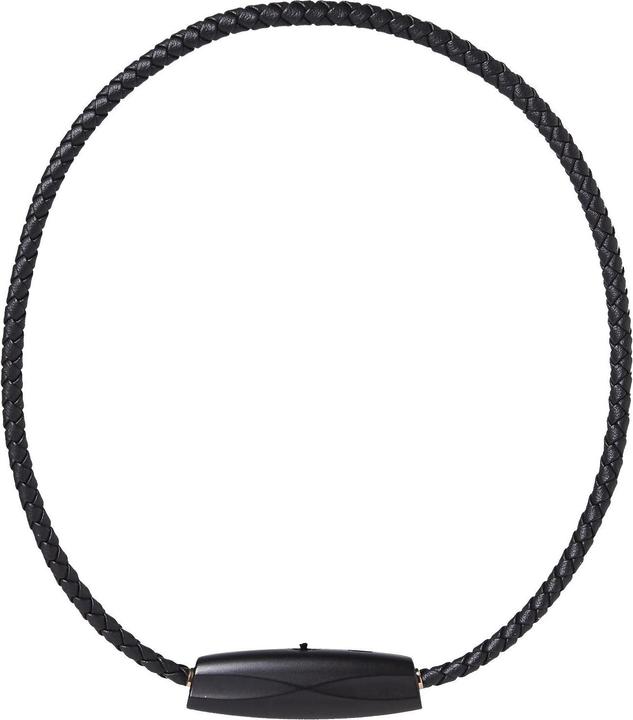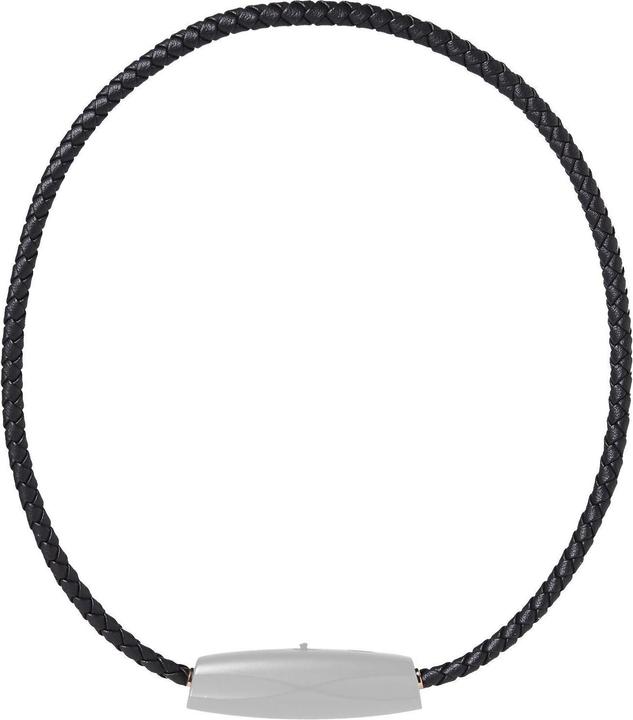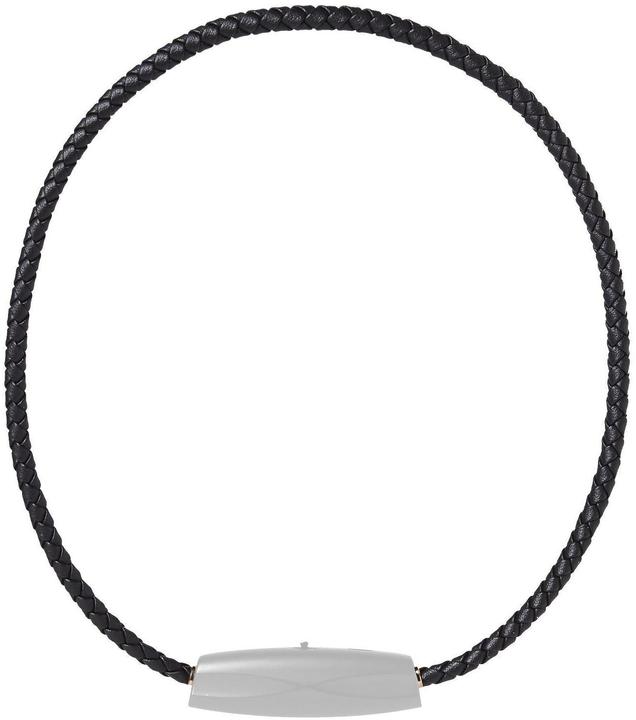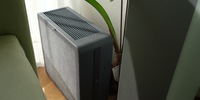
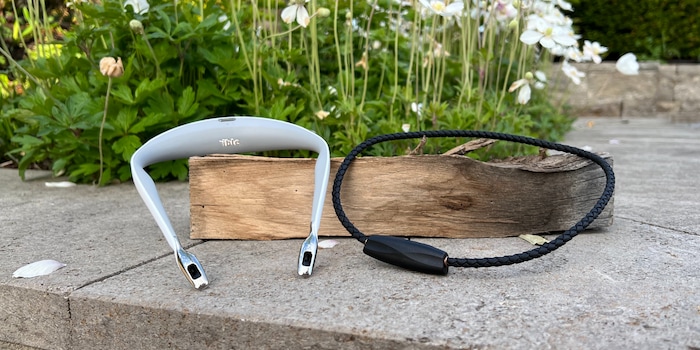
Testing the Ible Airvida: fewer «achoos!» thanks to ions in front of your nose
Elegant and futuristic, this wearable air purifier is said to protect you from bacteria, dust and pollen. But how does the roughly-200-franc gismo really fare? I’ve tested it to find out.
I sometimes shout «me!» in the wrong places. It was the same story when Ludo, a colleague from our Category Management team, thrust a new product under my nose. «Interesting», I thought, and it all sounds innovative, too. So, I agreed to put it through its paces. Not long afterwards, I got my hands on the Ible Airvida L1 and M1.
The first version is for women, the second for men. At least, that’s the way it’s marketed. The «men’s» version comes as a braided leather necklace a la suntanned surfer dude and has a magnetic catch. Though the black, plastic ion diffuser isn’t as flashy as a shark’s took, it’s not exactly ugly either.
More elegant, and downright futuristic, the «women’s» version of the L1 comes in Apple-style white. The metallic bits on each end house the core of the gadget – the two ionisers. At first, I felt the impulse to put it over my eyes and wear it in the style of Geordi La Forge from Star Trek. Which is, of course, wrong. It’s supposed to go round your neck.
Big promises from the manufacturer
It dawns on me that the Airvida has posed a hefty challenge as a test device. The technology, which supposedly purifies the air around me, is tricky to understand. What’s even more difficult, though, is that its day-to-day impact can’t be measured objectively. I can’t say with total certainty that I have fewer hay fever symptoms as a result of wearing the Airvida. Still, there is some indication that this is true.
The futuristic air purifier makes lofty promises. It’s supposed to get rid of pretty much every harmful particle from the air before you breathe them in. How? With the help of a chemical process called ionisation. Put simply, this means an electron breaks away from a molecule, becomes negatively charged and partners up with another atom as quickly as possible.
Technology and impact
To understand the principle behind the ioniser, you need to know some chemistry basics. During ionisation, one or more electrons are removed from an atom or molecule. The atom or molecule left over for a fraction of a second is the ion. This ion attracts harmful air particles such as pollen, bacteria and dust, creating a new, heavier compound which quickly falls to the ground. Supposedly, some particles, such as viruses and bacteria, are even broken down and rendered harmless. The ABC of Air Purifiers page (in German) explains the process in more detail with the help of graphics.
In simple terms, having a high ion content in the air is a good thing. There are loads of ions to be found in the air around waterfalls (70,000 ions per cubic metre) or mountains. In your average office, the figure drops to a considerably lower 100. Lucerne University is one of a number of institutions to measure this in a study (linked content in German). Here’s where Airvida comes in. It actually generates up to two million new ions every 0.6 seconds. If the advertising is to be believed, this gives the air you breathe the freshness of forest air.
Ozone, or O₃ as it’s known in chemistry, however, is produced by the ionisation process, too. Compared to O₂, which is inert, O₃ is much better at bonding. As a result, it’s a trusty micro-dust collector and supports other negative ions. On the other hand, [the ozone produced by air purifiers is controversial] because it’s a pollutant (https://vitalhelden.de/luft/ratgeber/ionisator-luftreiniger/) (linked article in German). Ible points out that its Airvida device only generates 0.006 parts per million (ppm), which is just 10 per cent of the limit set by the EU Commission’s standard.
In spite of all this, the device obviously doesn’t produce air smelling of moss, pine needles and prancing deer. It’s a technical process which involves reactive ions being «produced» through electricity and friction within the tiny chambers of the Airvida. The result you get from that as the wearer is a barely noticeable flow of air coming from the opening with the carbon fibre brushes.
Handling and design
The basic difference between the L1 and the M1 is how you wear them. The L1 is a neckband which, thanks to rubber coating on the inner side, is a soft, gentle fit. On the other hand, it’s less pleasant to wear while doing sport or working up a sweat. Going jogging with it isn’t a good idea. On sweat-dampened skin, the device quickly feels sticky. Mind you, at least it can easily be wiped clean. The air ducts for the negative ions are found on the front of the device at either side of my chin. This is where their anti-pollen, anti-bacteria, anti-everything benefit takes effect.
With the M1, the men’s version, the ion diffuser is part of the neckband, like a pendant. It’s definitely the less noticeable version.
Both devices can be turned on and off via a simple button. On the L1, there’s a blue LED light. You can check it’s working by pressing the Ible lettering on the device. This causes a soft whistling sound to come out of the openings at the front. M1 doesn’t have a light, so you need to feel the effect, as shown in this manufacturer’s video.
The video also explains how to clean the activated carbon fibre brush so that it doesn’t get clogged and prevent new negative ions from being diffused. To do this, you get the metal bit from the box and gently stroke above and between the bristles. It’s a bit like combing the mohawk of a very, very, very small pet.
If the brush cleaner looks familiar to you, you’re probably an Apple stalwart. The little compartment housing an iPhone SIM card is opened with exactly the same tool used to clean the Airvida brush. (I’ve tested it myself.) They may well come off the same assembly line in the same Taiwanese factory.
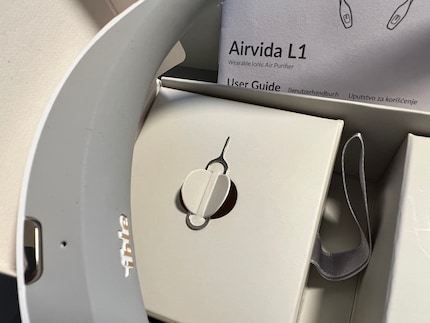
What Airvida unfortunately didn’t crib from Apple is its charging port. Instead, it’s equipped with the unpopular Micro USB port. Five volts flow directly into the band of the women’s version. Men, on the other hand, have to take the ion generator off the neckband first, shimmy it into a charger and plug it in. On both Airvidas, a red light tells you that the device is charging. When it’s done, the light turns green. What you don’t know, however, is how much juice the ionisers have left: there’s no battery life display.
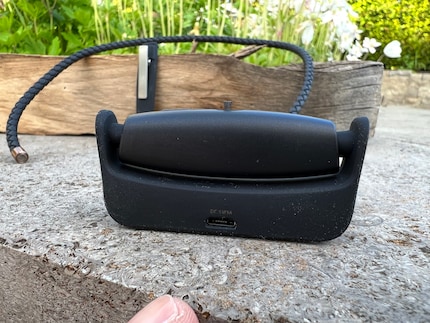
When it comes to battery life, there’s not much between the two versions. According to the packaging, it’s 28 hours for men versus 32 hours for women. Which pretty much tallies with my experience. The L1 pays for those extra four hours by having a considerably higher weight of 70 grammes. In contrast, the male version is a flyweight at 20 grammes.
You’ll become aware of your neck apparel, however, if you bend over often, say when you’re tying your shoes. It could well be the case that I have a weird neck width to chin ratio. Either way, the 50-centimetre-long band dangled around my chin just enough for the carbon fibre brushes to have a tickly rendezvous with my skin. In a super annoying way. Our shop sports longer and shorter versions of the neckband – likely with guys like me in mind. You’ll pay a princely sum for them, though. Ible justifies this with the fact that the titanium necklace provides far infrared radiation, which is supposed to stimulate your circulation and metabolism.
Fortunately, there’s another, budget-friendlier alternative to the chain. The M1 comes with a clip, which holds the ion diffuser in place on the collar of your shirt.
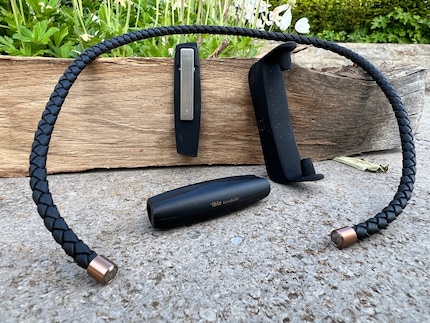
Verdict: the scientific basis is thin, but it feels effective
I feel the effect of the Airvida ioniser in pollen season in particular, specifically in April and May. It doesn’t matter whether it’s birches, hazel, dock, grasses or other plants shedding their pollen. As long as I’ve got my neckband or Star Trek-style gismo on, I can be out and about in the open air pretty much without sneezing. The thing seems to work somehow, which I can technically understand thanks to the studies. Still, it’s hard to believe. After all, Airvida does its job so quietly that you basically don’t notice, hear or feel it. The anti-allergy tablets which I could take as an alternative make me tired. I’m happy to go without this particular creation of the pharmaceutical industry.
Thanks to the long battery life, it meshes well with my daily routine. I can wear it all day for two days straight, and charge it overnight after the second day. You can bet your bottom dollar that some people will get het up over the micro USB port in the comments section. Although I don’t enjoy the fiddling either, my blood pressure doesn’t exactly shoot up on the one or two occasions I plug it in.
When it comes to the product’s design, it’s a question of taste. And as we all know, there’s no arguing over that. The men’s version’s dangling around my chin is irritating. I prefer the ladies’ version. The thing is, it only just fits me (my collar width is 39/40). If you’ve got a stronger neck, you’ll have to switch to the men’s version. What you could also do, though, is put the device on your desk to purify the air. If you’re in the office, lots of people will ask you what it is. I was certainly asked a few times. With the necklace, I mostly got confused glances because I’ve never struck anybody as the type to wear jewellery. When I had the high-tech version around my neck, nobody batted at eyelid. Not even at the little black thing in the charging station, the discreet version I’d sometimes put on my desk.
I’ve got more confidence in the ladies version with its ionisers to the left and right to create a curtain of fresh air around my face. I’ll continue using it whenever a high pollen count is forecast.
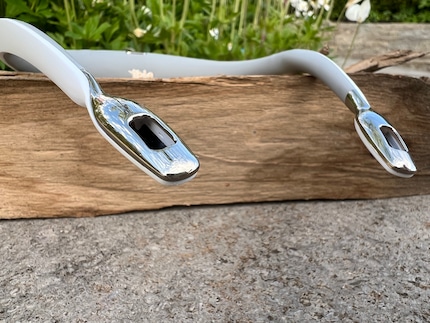
By the way, according to the Lucerne University study, air that’s more heavily populated by ions contributes to increased «general well-being». Some participants actually reported feelings of calm. Other studies even report a reduction in migraines. Nevertheless, the scientific basis for this, as well as for the Airvida gadget itself, is still pretty thin. Which means the findings aren’t really set in stone yet. In East Asia in particular, there are more proponents of air ionisation. There, people tend to think beyond western-influenced conventional medicine and are possibly more open to new solutions.
Got any questions or comments about my review? Or have you tried the Airvida, too? Share your experiences with the Community and me in the comments.
Journalist since 1997. Stopovers in Franconia (or the Franken region), Lake Constance, Obwalden, Nidwalden and Zurich. Father since 2014. Expert in editorial organisation and motivation. Focus on sustainability, home office tools, beautiful things for the home, creative toys and sports equipment.
